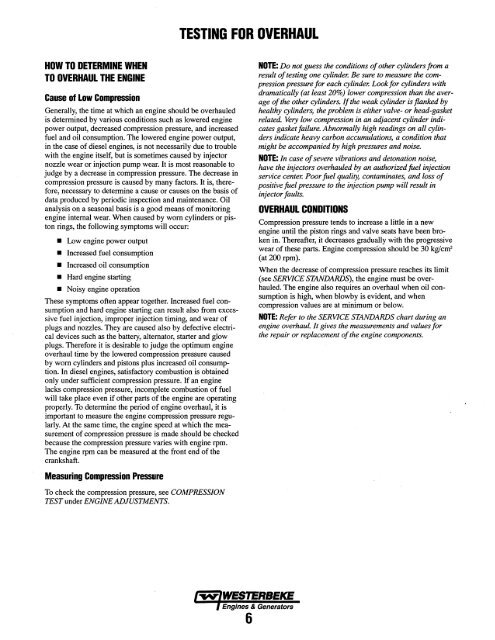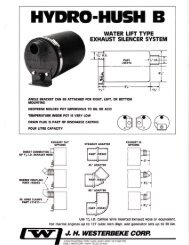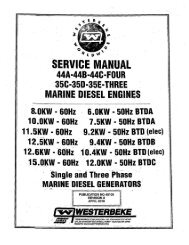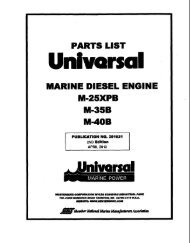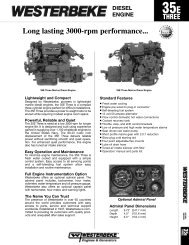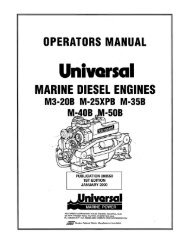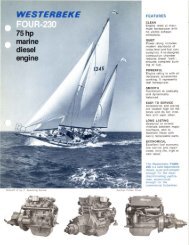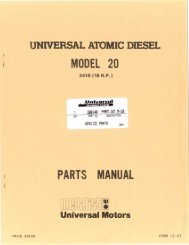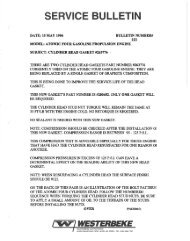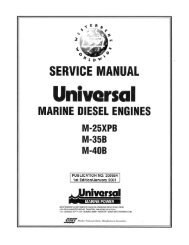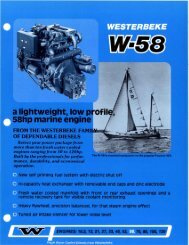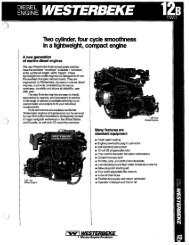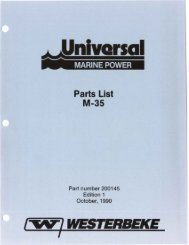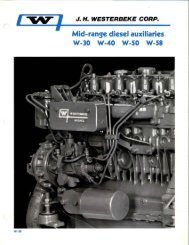service manual 55a four marine diesel engine - Westerbeke
service manual 55a four marine diesel engine - Westerbeke
service manual 55a four marine diesel engine - Westerbeke
Create successful ePaper yourself
Turn your PDF publications into a flip-book with our unique Google optimized e-Paper software.
TESTING FOR OVERHAUL<br />
HOW TO DETERMINE WHEN<br />
TO OVERHAUL THE ENGINE<br />
Cause of Low Compression<br />
Generally, the time at which an <strong>engine</strong> should be overhauled<br />
is determined by various conditions such as lowered <strong>engine</strong><br />
power output, decreased compression pressure, and increased<br />
fuel and oil consumption. The lowered <strong>engine</strong> power output,<br />
in the case of <strong>diesel</strong> <strong>engine</strong>s, is not necessarily due to trouble<br />
with the <strong>engine</strong> itself, but is sometimes caused by injector<br />
nozzle wear or injection pump wear. It is most reasonable to<br />
judge by a decrease in compression pressure. The decrease in<br />
compression pressure is caused by many factors. Itis, therefore,<br />
necessary to determine a cause or causes on the basis of<br />
data produced by periodic inspection and maintenance. Oil<br />
analysis on a seasonal basis is a good means of monitoring<br />
<strong>engine</strong> internal wear. When caused by worn cylinders or piston<br />
rings, the following symptoms will occur:<br />
• Low <strong>engine</strong> power output<br />
• Increased fuel consumption<br />
• Increased oil consumption<br />
• Hard <strong>engine</strong> starting<br />
• Noisy <strong>engine</strong> operation<br />
These symptoms often appear together. Increased fuel consumption<br />
and hard <strong>engine</strong> starting can result also from excessive<br />
fuel injection, improper injection timing, and wear of<br />
plugs and nozzles. They are caused also by defective electrical<br />
devices such as the battery, alternator, starter and glow<br />
plugs. Therefore it is desirable to judge the optimum <strong>engine</strong><br />
overhaul time by the lowered compression pressure caused<br />
by worn cylinders and pistons plus increased oil consumption.<br />
In <strong>diesel</strong> <strong>engine</strong>s, satisfactory combustion is obtained<br />
only under sufficient compression pressure. If an <strong>engine</strong><br />
lacks compression pressure, incomplete combustion of fuel<br />
will take place even if other parts of the <strong>engine</strong> are operating<br />
properly. To determine the period of <strong>engine</strong> overhaul, it is<br />
important to measure the <strong>engine</strong> compression pressure regularly.<br />
At the same time, the <strong>engine</strong> speed at which the measurement<br />
of compression pressure is made should be checked<br />
because the compression pressure varies with <strong>engine</strong> rpm.<br />
The <strong>engine</strong> rpm can be measured at the front end of the<br />
crankshaft.<br />
Measuring Compression Pressure<br />
NOTE: Do not guess the conditions of other cylinders from a<br />
result of testing one cylinder. Be sure to measure the compression<br />
pressure for each cylinder. Look for cylinders with<br />
dramatically (at least 20%) lower compression than the average<br />
of the other cylinders. If the weak cylinder is flanked by<br />
healthy cylinders, the problem is either valve- or head-gasket<br />
related. Very low compression in an adjacent cylinder indicates<br />
gasket failure. Abnormally high readings on all cylinders<br />
indicate heavy carbon accumulations, a condition that<br />
might be accompanied by high pressures and noise.<br />
NOTE: In case of severe vibrations and detonation noise,<br />
have the injectors overhauled by an authorizedJueI injection<br />
<strong>service</strong> center. Poor fuel quality, contaminates, and loss of<br />
positive fuel pressure to the injection pump will result in<br />
injector faults.<br />
OVERHAUL CONDITIONS<br />
Compression pressure tends to increase a little in a new<br />
<strong>engine</strong> until the piston rings and valve seats have been broken<br />
in. Thereafter, it decreases gradually with the progressive<br />
wear of these parts. Engine compression should be 30 kg/cm2<br />
(at 200 rpm).<br />
When the decrease of compression pressure reaches its limit<br />
(see SERVICE STANDARDS), the <strong>engine</strong> must be overhauled.<br />
The <strong>engine</strong> also requires an overhaul when oil consumption<br />
is high, when blowby is evident, and when<br />
compression values are at minimum or below.<br />
NOTE: Refer to the SERVICE STANDARDS chart during an<br />
<strong>engine</strong> overhaul. It gives the measurements and values for<br />
the repair or replacement of the <strong>engine</strong> components.<br />
To check the compression pressure, see COMPRESSION<br />
TEST under ENGINE ADJUSTMENTS.<br />
Engines & Generators<br />
6


